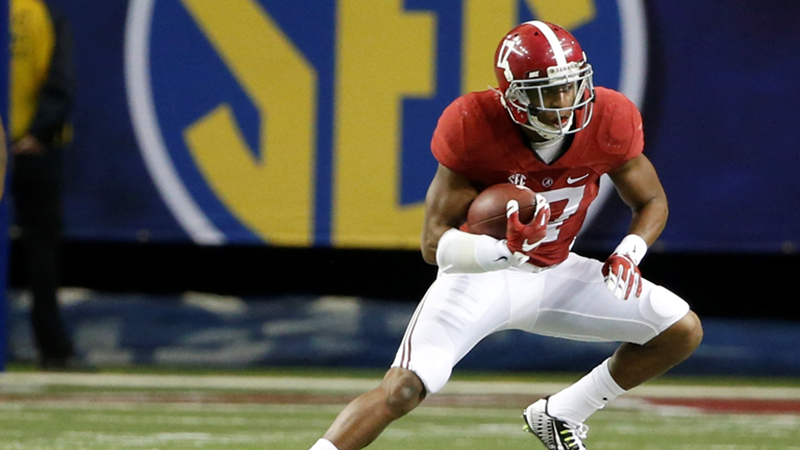Researchers join with Athletics to integrate technology, sports
By Adam Jones and David Miller
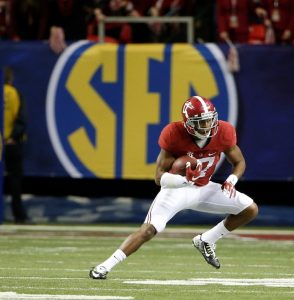
A stiff-arm in a football game is a signature move, a classic technique for ball carriers to use their momentum to bulldoze a tackler out of the way.
It’s so revered that it’s enshrined as the pose for the figure atop college football’s most iconic award, the Heisman Trophy.
And, when a star player for The University of Alabama with an injured arm instinctively stiff-armed an opposing player in the 2015 Southeastern Conference Championship Game, he was able to do so thanks to doctors, athletic trainers, engineering students, professors and a 3-D printer.
Kenyan Drake, a running back for the 2015 Crimson Tide, broke an arm in the second half of the season. Fortunately, the break was in the smaller of the two bones in his forearm, so recovery time was shorter. Incredibly, three weeks after the break, he was back on the field.
On the first offensive play from scrimmage, Drake caught a pass, put the ball in his healthy arm and stiff-armed, with the other, the approaching defender, gaining more yardage.
The play was the culmination of collaboration between Crimson Tide Athletics and the UA College of Engineering. Protecting the surgically-repaired bone was a carbon-fiber brace, 3-D printed off a 3-D scan of Drake’s arm, work done in a lab across campus from the football training facility.
“When I saw him stiff arm, I winced, but it worked,” says Dr. Ken Fridley, a College of Engineering administrator who helped with the project.
Drake’s brace is on a growing list of projects between athletics and academics at UA, joining top-shelf athletes with leading-edge researchers in mutually beneficial situations.
To make the relationship formal, UA System trustees established the Integrative Center for Athletic and Sport Technology, or I-CAST, a research center devoted to the development of new technologies and the application of existing technologies for the purposes of reducing injury, accelerating recovery from injury, enhancing human performance and optimizing nutrition in performance and recovery.
“I-CAST opens the door for a lot of possibilities and great collaboration between athletics and academics that would be unparalleled on any college campus across the country,” says Jeff Allen, assistant athletic director for sports medicine. “This will benefit our student athletes, helping them have success and keeping them healthy.”
The center draws on expertise from the fields of engineering, exercise science, health science, athletic training, nutrition and kinesiology, giving researchers access to top-notch athletes in UA’s varsity programs as well as the University’s internationally-known Adapted Athletics.
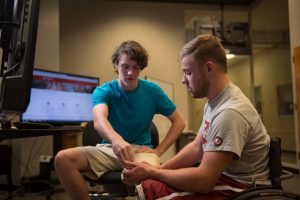
“Interdisciplinary is a big buzz word in academics, but few people do it in a way that connects people from across the same campus,” says Dr. Elizabeth Hibberd, I-CAST associate director. “It’s unique that all these sides of campus are coming together to improve patient care.”
The beginnings of I-CAST came in the summer of 2015, when Allen approached his friend, Dr. Charles L. Karr, dean of the UA College of Engineering. Allen wanted a tent that could be easy to transport and quick to set up on the sideline so doctors and trainers could evaluate injuries in privacy, instead of in view of fans, opposing teams and TV cameras.
Karr handed the project to four seniors in mechanical engineering who designed the collapsible tent that can be carried by one person and set up or taken down within a few seconds – all without blocking the field from the view of fans and reporters.
The students drew on mechanical design and material science, and it was used throughout the 2015 season, garnering national attention within the athletic training community and in the media.
The patent-pending tent was so successful two of the students and Allen spun off a company to market and sell the tent, now called the SidelinER. In 2016, more than 50 football teams and an NFL team used the tent.
“That’s been a gigantic game-changer for us both from a privacy standpoint and a medical-care standpoint,” Allen says. “It allows you to have a more effective and better medical exam on the sideline. When you are dealing with all the distractions that come with being on the sideline, the SidelinER creates that private area where it’s just the athletic trainer, the doctor and the athlete.”
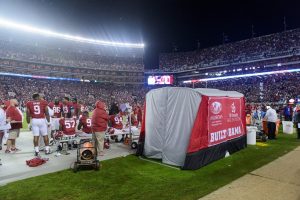
The SidelinER is a model for how I-CAST can work, said Dr. Tim Haskew, director of I-CAST. The project took a relatively simple problem with no existing solution and applied known techniques and knowledge.
“A lot of the issues that high-level sporting fields deal with are things where technology already exists to deal with the issue, but the technology just has not been applied in that way before,” he says.
Similar projects include adapting a golf cart to carry a refrigerated water tank that sprays players practicing in the heat, something the football team began using at practice in 2016.
Students and a professor designed a case for Apple iPads that cools the tablet computer while it is used during a hot practice, stopping the iPad from shutting off from overheating. Even the brace for Drake, now with the Miami Dolphins, applied an existing technology for a specific athletic need.
“We could have fabricated some type of cast or heavy padding, but, at his position, that’s not functional as a running back,” Allen said. “They were able to do a custom-fit, carbon-fiber brace that was incredibly light and very functional. It allowed him to play with no restrictions but also to be protected.”
Professors are also working with UA Adapted Athletics to improve designs used by athletes in wheelchairs.
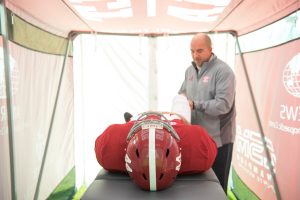
In the rough-and-tumble sport of wheelchair basketball, for example, athletes need to be secured to the chairs while retaining free movement of their upper bodies. Often straps are adapted from snowboarding or use ratchets from cycling that quickly wear out.
“They are not being used for what they are designed for, so they don’t work as well,” Haskew says.
Engineering students worked with athletes to devise inserts made of 3-D printed nylon and Kevlar that slip onto the straps to prevent material fatigue.
Another issue was the grips used by athletes who race in wheelchairs. Existing grips, typically made of self-molding plastics, easily wear out. Students worked with a former UA student who participates in marathons to develop a 3-D printed grip that should be more durable.
Other projects with UA Adapted Athletics continue as the director of the program, Dr. Brent Hardin, is an I-CAST participant.
“These are high-level, extremely-talented athletes that are being somewhat limited by their equipment, and, for us, that’s something that needs to be addressed,” Haskew says.
Haskew hopes the more practical, immediate projects end up producing the relationships and intellectual property that, in turn, can help further more advanced academic research.
One such project is ongoing between UA Athletics and kinesiology. Dr. Michael Esco, an exercise scientist, and Andrew Flatt, a doctoral candidate, say expanding the clinical physiological measure of heart-rate variability into sports science may improve athletic performance and reduce injuries.
Esco and Flatt, among other exercise science students, are working with the UA football team to provide data to team trainers.
Heart rate variability, or HRV, measures the variations between consecutive heartbeats. It is an internal indicator of how well a body is ready to perform on a given day. Measuring HRV regularly can provide trainers data on an athlete’s levels of rest and recovery.
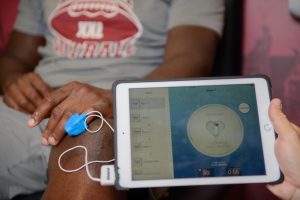
The metric has traditionally been used more for clinical purposes, but Esco, Flatt and their team use it more as a measurement of recovery and readiness to perform. They capture HRV data in UA athletes on a daily basis via electrocardiogram and smartphone/tablet applications.
“Even though athletes lift on the same type of program, they’ll all react differently,” Esco says. “We can look at how well someone is adapted to a particular stimulus, which depends on athletic status. For some people, heavy workouts may cause HRV to drop, while others may experience no change in HRV.
“So, we’re getting to the point where HRV may be used to undulate a training program and individualize a workout stimulus based on that information.”
In previous studies with swim, soccer, and endurance athletes, the researcher found athletes whose HRV readings had tighter fluctuation day-to-day performed better in their events and had a better state of recovery.
Esco and Flatt hope to expand HRV research to reflect physiological readiness in military members and others. The broader implications of I-CAST projects should reach beyond sports to industrial workforce, healthcare, physical therapy and military fields.
“A lot of people are required to have agility, stamina and other athletic traits at their jobs,” says Dr. Jonathan Wingo, I-CAST associate director. “We should be able to take something we do and apply it to situations we had not even thought of when we started out. That’s exciting.”
Allen is assistant athletics director for sports medicine, and Esco is an associate professor of exercise science in the College of Education. Fridley is senior associate dean for administration in the College of Engineering, and Hardin is an associate professor of adapted sport pedagogy. Haskew heads the department of electrical and computer engineering, and Hibberd is an assistant professor in the department of health science in the College of Human Environmental Sciences. Wingo heads the department of kinesiology.
